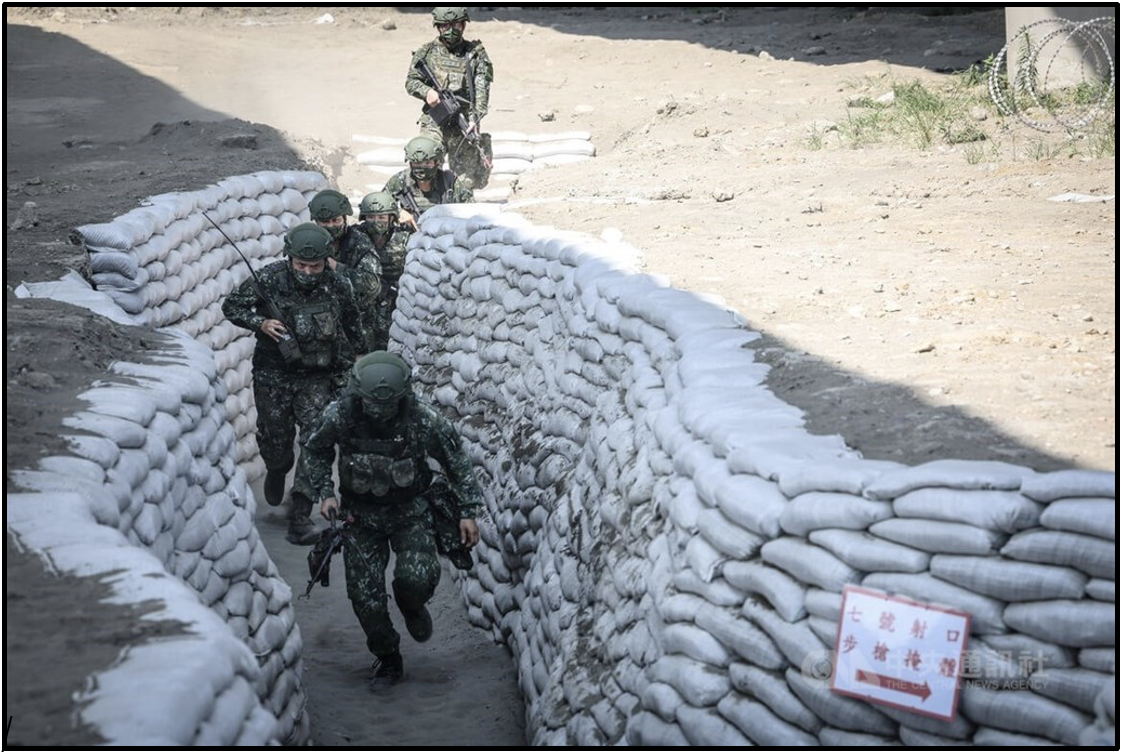Taiwan and the United States are running out of time to restore effective deterrence in the Taiwan Strait. A critical path to the restoration of deterrence may be found in the implementation of a more effective program of training for the Republic of China (ROC) Army. Among the branches of the ROC military, the army is the force most intimately involved in the defense of Taiwan and its people—and it is also the service branch most in need of reform. The good news is that substantive reform is possible, and that it could have an outsized effect on both internal morale and cross-Strait deterrence in the near term.
The war in Ukraine offers a “battle laboratory” that we must mine for operational concepts suitable for the ROC Army. A force configured for actively maneuvering defense—executed by widely distributed, operationally resilient force elements equipped with precision weapons able to engage the enemy at distance—will be decisive. An army drawn from a democratically governed nation, which is comfortable with distributing information and delegating authority down command echelons, has a powerful advantage over centrally controlled and directed forces. Agile, mobile, and hostile forces can frustrate much larger opponents: think of such forces as energetic and aggressive “honey badgers,” as opposed to a “porcupine” force in a static position.
Challenges Facing the ROC Army
But there is work to be done. ROC Army combat units have varying personnel shortages across the ranks. The army has been called a “hollow shell,” with effective manpower levels estimated to fall between 60 and 80 percent of requirements. In previous decades of the martial law era (which ended only in the late 1980s), conscription maintained force levels in the ROC military, with conscripts serving on active duty for two years. As Taiwan became a vigorous, even raucous, democracy, the term of service for conscripts steadily decreased to four months, where it stands now. President Tsai has announced plans to raise the conscripted term of service to one year—an improvement, but still a term of service inadequate to produce a skilled and well-trained force.
Personnel issues contribute to training issues. Currently, five weeks of basic training—a term well short of the required time necessary to truly indoctrinate soldiers with basic military skills—precedes assignment to field units to complete specialty training. Field units rarely specialize in individual training in any force, in any nation. This process fails in the context of Taiwan’s army, as well.
Anecdotal reports reveal that conscripted soldiers are frequently treated as temporary help, and stories abound about recruits being assigned basic landscaping and janitorial duties. Weapons are shared among many soldiers for rare live-fire training. Little attention is devoted to explaining, developing, and training on the means and measures by which the army expects to defend Taiwan. As one soldier has stated: “By design, [conscripts] don’t participate in any field exercise or combat readiness training anyway, we just tell them to stay safe and don’t get into trouble. It’s basically a summer camp.” The army’s reputation suffers as a result of new conscripts reporting such unsatisfactory experiences.
The most damning observations come from the most senior observers. As was noted in a recent Wall Street Journal article, citing former ROC Chief of Staff Admiral Lee Hsi-min (李喜明):
Currently, most draftees spend their time cleaning floors and picking weeds rather than learning how to repel Beijing’s People’s Liberation Army, said ret. Adm. Lee Hsi-min, a former chief of Taiwan’s military who has become a vocal critic of the island’s military preparedness. “If you just do the same things for a year instead of four months, then you have a problem and a bad reputation,” he said. “The problem is the training content, not the training period. How you do it is much more important than how long you do it.”
Not surprisingly, Taiwan’s army is further challenged by retention issues. Taiwan press reporting has noted problems with poor performance and disciplinary issues, leading in 2022 to over 4,000 soldiers either being expelled or applying for early release from their service contracts (the latter in exchange for compensation payments). These problems, linked with low morale, significantly contribute to personnel shortages. The image of an understaffed army with inadequate, token training damages the institution, discourages potential future recruits, and imperils deterrence.
These problems also create doubts about Taiwan’s defense capability that will be prominently featured in political debates as we approach Taiwan’s January 2024 elections. Chinese information operations directed against Taiwan will be seeking to exacerbate these doubts, as well as to sow further doubts regarding the reliability of international support for Taiwan.

Image: ROC Army reservists take part in a counter-amphibious landing drill as part of the annual Han Kuang military exercise in July 2022. (Image source: CNA)
The Social Contract and Taiwan’s Defense
The good news is that this state of affairs can be turned around. But time is short.
The ROC Army, Air Force, and Navy—including the Navy’s Marine Corps—are charged with the defense of Taiwan. As in any democratic nation, the services have a compact with the population and the government. Each service must have a concept of how, when and where it expects to protect Taiwan against threats to the nation. Taiwan’s population must provide the resources, both human and material, to support the services in direct proportion to the perceived value of a service’s concept. In turn, the service is responsible for creating an organization that can make the best use of the resources provided.
That is especially true for a nation’s most precious resource, the young men and women that are called to its service. The training regime is a critical element of a service’s structure—and if that is inadequate, the resources from the broader society will not be provided. The service will become purposeless, wallowing about amid a variety of conflicting and confusing goals, and will ultimately suffer both physical and moral degeneration.
The ongoing Ukraine war illustrates once again the advantages of a military force drawn from a democratic nation. Commanders at all levels do not have to wait for direction from some omnipotent supreme headquarters. The current state of technology and geopolitics both provide advantages to forces in a defensive posture, if those forces can operate in a widely distributed, operationally resilient, and mobile posture, with authorities and initiative pushed down the chain of command to the smallest units. (See the author’s earlier commentary on such a force posture here.)
Implementing the Overall Defense Concept—and the Critical Role of Training
Taiwan’s Overall Defense Concept (ODC) calls for just such a force posture—and furthermore, Taiwan’s Minister of Defense Chiu Kuo-cheng (邱國正) has declared his priorities to be range, precision, and mobility. Taiwan’s armed forces need a well-defined strategic concept based on the ODC, and this is a matter particularly important for the ROC Army. The army needs a rigorous, well-defined training structure and organization in order to become the force that Taiwan (and its primary ally, the United States) needs it to be. The army’s concept or “way of war” must be built from the ODC and the minister’s guidance. It can and should become the foundation for joint action by all of Taiwan’s services.
Support of this concept, and the defense of Taiwan, demands professionalizing the ROC Army’s training establishment. The organization of training is not an art, but rather a science: one built upon tasks, conditions, and standards of performance. It requires training objectives directly drawn from the concept. The process builds directly from individual training to major unit training. Help may be at hand: Taiwan’s forces are increasing their participation in training in the United States. In addition, US personnel reportedly have been deploying to Taiwan to support training since 2021, and that effort is expanding. Such combined training efforts represent a needed corrective to the isolation that Taiwan’s forces have endured since 1979, and should be a key step on the critical path to restoring effective deterrence in the Taiwan Strait.
The key to success is strong support for rigorous training to accomplish properly assigned tasks, accomplished under appropriate conditions, and implemented to the required standards of performance. Rigorous, well-organized training, with detailed records and strict enforcement of standards, produce a well-trained and confident force. Confidence emerges from acquiring individual and collective skills, and the realization that the country can be defended. These measures can be accomplished, but action must be taken now if Taiwan is to restore a credible deterrent defense.
The main point: Taiwan’s army faces significant challenges with morale and recruiting. The most important step to address these challenges is to adopt a more rigorous program of training, which would be intended to develop a more agile fighting force capable of effectively implementing the strategic posture outlined by the Overall Defense Concept.




